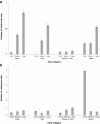A survey of visitors on Swedish livestock farms with reference to the spread of animal diseases
- PMID: 24040830
- PMCID: PMC3848732
- DOI: 10.1186/1746-6148-9-184
A survey of visitors on Swedish livestock farms with reference to the spread of animal diseases
Abstract
Background: In addition to livestock movements, other between-farm contacts such as visitors may contribute to the spread of contagious animal diseases. Knowledge about such contacts is essential for contingency planning. Preventive measures, risk-based surveillance and contact tracing may be facilitated if the frequency and type of between-farm contacts can be assessed for different types of farms. The aim of this study was to investigate the frequency and types of visitors on farms with cloven-hoofed animals in Sweden and to analyse whether there were differences in the number of visitors attributable to region, season, and type of herd. Data were collected from Swedish farmers through contact-logs covering two-week periods during four different seasons.
Results: In total, 482 (32%) farmers filled in the contact log for at least one period and the data represent 18,416 days. The average number of professional and non-professional visitors per day was 0.3 and 0.8, respectively. Whereas the number of professional visitors seemed to increase with increasing herd size, this relation was not seen for non-professional visits. The mean numbers of visitors per day were highest in the summer and in the farm category 'small mixed farm'. Reports of the visitors' degree of contact with the animals showed that veterinarians, AI-technicians, animal transporters and neighbours were often in direct contact with the animals or entered the stables and 8.8% of the repairmen were also in direct contact with animals, which was unexpected. In a multivariable analysis, species, herd size and season were significantly associated with the number of professional visitors as well as the number of visitors in direct contact with the animals.
Conclusion: In conclusion there was a large variation between farms in the number and type of contacts. The number of visitors that may be more likely to spread diseases between farms was associated with animal species and herd size.
Figures


References
-
- Anonymous. Regulation (EC) No 1760/2000 of the European parliament and of the council of 17 July 2000 establishing a system for the identification and registration of bovine animals. Off J. 2000;L:1–10.
-
- Radostits OM, Gay CC, Blood DC, Hinchcliff KW. Veterinary Medicine A Textbook of the Diseases of Cattle, Sheep, Pigs, Goats and Horses. 9. Harcourt Place, 32 Jamestown Road, London NW1 7BX: Harcourt Publishers Limited; 2000.
-
- Ohlson A, Emanuelson U, Tråven M, Alenius S. The relationship between antibody status to bovine corona virus and bovine respiratory syncytial virus and disease incidence, reproduction and herd characteristics in dairy herds. Acta Vet Scand. 2010;52:37. doi: 10.1186/1751-0147-52-37. - DOI - PMC - PubMed
Publication types
MeSH terms
LinkOut - more resources
Full Text Sources
Other Literature Sources

